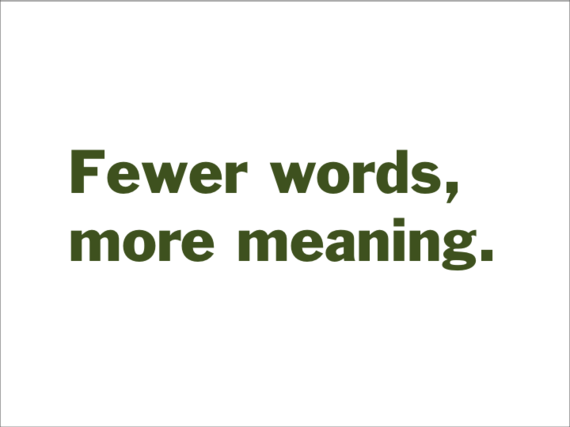Last time, I introduced the power of a good angle for both speeding and improving your writing. Today I'll go into more detail on how choose that angle.
The most important question to ask yourself is the simplest: "What the heck am I actually trying to say?"
As, it happens, this also is one of the hardest questions. That's because:
- You must truly understand your subject. That means work.
- You must commit to an idea that may turn out to be wrong or unpopular. That means risk.
It's easier and safer to hide behind big words, jargon and ambiguity. And that's pretty much what we're trained to do, at school and at work.
But it's not what a good writer does.
A good writer produces not just words, but meaning. Good writers are actually in the writing-reduction business: they aim to score a high ratio of meaning to words.
To do that, do this:
Clear away clutter until you have nothing left except one important point. Then state it in the simplest language you can muster.
Consider these recent headlines from the New York Times:
Not a word wasted, even in the last and longest. In nine words, that one states a striking, specific fact, which draws you into the full story. As you might expect, that story turns out to have a larger subject:
[The] price increase is not an isolated example.... there is also growing concern about huge price increases on older drugs, some of them generic, that have long been mainstays of treatment.
If you learn to write like this, I predict you'll notice an increase in the impact and authority of what you say. The reason is simple: you'll have earned it, by offering solid value.
I'll leave you for now with some exercises:
1. Try putting all the content of your email in the subject line. See if you can make your entire point like this:
Tomorrow's call has been moved to 3:30.
That's it, done. Busy co-workers will love you deeply. If you need to say more than one thing, send separate emails, one per topic.
2. For presentation slides: If you have multiple bullet points, delete all of them except one. Simplify that, and make it really big. For example:
You can put the other points on separate slides, or move them to your speaker's notes.
3. Convert all generic titles to meaningful ones. For example, change this:
Q4 Results
to this:
Q4: Transactions Up, Revenue Flat
4. Use Twitter to improve your meaning-to-words ratio. Tweets have a maximum of 140 characters, but you should often leave room for:
- A shortened link, which will take 20 or so characters
- A hashtag, for another 10 or so
- An image, for another 23 if you're using a Twitter image url.
That leaves 100 or fewer characters for your text.
Here are some possible tweets for the post you're reading now, with character counts:
To write better, start by knowing what the heck you mean. [57]
Write better: Boost your meaning-to-words ratio. [48]
How tweeting can make you a better writer. [42]
Good writing is less writing. [29]

